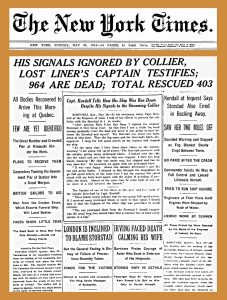
Photo:Public Domain (Library and Archives Canada / PA-116389)
The Titanic disaster of 1912 was still making waves when on 29 May 1914, the RMS Empress of Ireland collided with the Norwegian coal freighter Storstad in the Saint Louis River at Pointe-au-Père, Quebec. It occurred around 0200 in the morning. Storstad hit the starboard side, causing severe damage. Empress began to list and quickly filled with water. Portholes had not been secured before leaving port so many were open (many passengers complained of poor ventilation) so that allowed a lot of water to enter. Many in the lower decks drowned from water coming in from the open portholes.

Public Domain via Wikimedia Commons
Also, failure to close the watertight doors led to the quick sinking. Three lifeboats were launched quickly with passengers and crew that were in the upper deck cabins able to get away but as the ship listed further starboard, the other lifeboats could not be used. Ten minutes after the collision, Empress lurched violently on the starboard side allowing 700 passengers and crew to crawl out of portholes and decks on her side. Then 15 minutes later, after it briefly looked like she might have run aground, the hull sank dumping all the people left on her into the icy water. When the final tally was done, 1,012 people lost there lives. 465 survived. Many on the starboard side were asleep and likely drowned in their cabins.

Public Domain via Wikimedia Commons
The official enquiry, which began on 16 June 1914, was headed by Lord Mersey who had previously headed the British Titanic enquiry (he would also lead up the enquiry into Lusitania later). Two very different accounts emerged of the collision from the Storstad and Empress. At the end of the day, the commission determined that when Storstad changed course, it caused the collision. The Norwegians did not accept the verdict and held their own enquiry which exonerated the captain and crew of the Storstad. Canadian Pacific, which owned the now sunk Empress of Ireland, pursued a legal claim and won. The Norwegian owners countersued but in the end the liabilities forced them to sell Storstad to put money in the trust funds.
What happened to Empress, though not receiving the same attention as Titanic, was to change ship design. The reverse slanting bow was dangerous in ship-to-ship collisions resulting in below the waterline damage. Bows were redesigned so the energy of the collision would be minimized below the surface. Longitudinal bulkheads were discontinued as they trapped water beneath them causing the ship to list and capsize. Needless to say portholes were to be secured from that point on (in fact nearly all cruise ships use decoratives that can never be opened). The wreck today has been salvaged many times and is now the only underwater historic site in Canada. The wreck is in shallow water (130 feet) but is notably dangerous dive due to the cold waters, currents, and often impaired visibility.
Sources:
Turcotte, Dorothy. “The Empress of Ireland Was Canada’s Titanic.” Grimsby Lincoln News, Niagara This Week, 2 July 2013, www.niagarathisweek.com/opinion/columnists/the-empress-of-ireland-was-canada-s-titanic/article_2b417429-aa48-5dd5-a61c-a2f6f208b0fb.html?
ARCHIVED – Investigating the Empress of Ireland – Inland Waters – Shipwreck Investigations – Library and Archives Canada. www.collectionscanada.ca/sos/shipwrecks/002031-4100-e.html.
“RMS Empress of Ireland.” Wrecksite, www.wrecksite.eu/wreck.aspx?30437. Accessed 28 May 2024.
—. “RMS Empress of Ireland.” Wikipedia, 22 May 2024, en.wikipedia.org/wiki/RMS_Empress_of_Ireland













